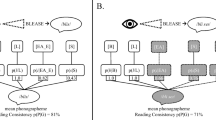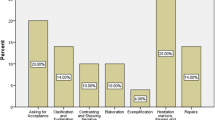Abstract
Erard's (2004) publication in the New York Times of a journalistic history of the filled pause serves as the occasion for this critical review of the past half-century of research on the filled pause. Historically, the various phonetic realizations or instantiations of the filled pause have been presented with an odd recurrent admixture of the interjection ah. In addition, the filled pause has been consistently associated with both hesitation and disfluency. The present authors hold that such a mandatory association of the filled pause with disfluency is the product of The written language bias in linguistics [Linell, 1982] and disregards much cogent evidence to the contrary. The implicit prescriptivism of well formedness—a demand derived from literacy—must be rejected; literate well formedness is not a necessary or even typical property of spontaneous spoken discourse; its structures and functions—including those of the filled pause—are very different from those of written language. The recent work of Clark and Fox Tree (2002) holds promise for moving the status of the filled pause not only toward that of a conventional word, but also toward its status as an interjection. This latter development is also being fostered by lexicographers. Nonetheless, in view of ongoing research regarding the disparate privileges of occurrence and functions of filled pauses in comparison with interjections, the present authors are reluctant to categorize the filled pause as an interjection.
Similar content being viewed by others
REFERENCES
American Heritage Dictionary. 2nd college ed. (1982). Boston: Houghton Mifflin.
American Heritage Dictionary of the English Language. 4th ed. (2000). Boston: Houghton Mifflin.
Arnold, J. E., Fagnano, M., & Tanenhaus, M. K. (2003). Disfluencies signal theee, um, new information. Journal of Psycholinguistic Research, 32, 25-36.
Biber, D. (1988). Variation across speech and writing. Cambridge: Cambridge University Press.
Boomer, D. S. (1963). Speech disturbance and body movement in interviews. Journal of Nervous and Mental Disease, 136, 263-266.
Boomer, D. S. (1965). Hesitation and grammatical coding. Language and Speech, 8, 148-158.
Bortfeld, H., Leon, S. D., Bloom, J. E., Schober, F., & Brennan, S. E. (2001). Disfluency rates in conversation: Effects of age, relationship, topic role, and gender. Language and Speech, 44, 123-147.
Carroll, J. B. (1964). Language and thought. Englewood Cliffs, NJ: Prentice-Hall.
Cassell's Italian Dictionary. (1977). New York: Macmillan.
Clancy, T. (2000). The Bear and the Dragon. New York: G. P. Putnam's Sons.
Clark, H. H., & Clark, E. V. (1977). Psychology and Language: An Introduction to Psycholinguistics. New York: Harcourt Brace Jovanovich.
Clark, H. H., & Fox Tree, J. E. (2002). Using uh and um in spontaneous speaking. Cognition, 84, 73-111.
Clark, H. H., & Wasow, T. (1998). Repeating words in spontaneous speech. Cognitive Psychology, 37, 201-242.
Collins Spanish Dictionary. 6th ed. (2000). New York: HarperCollins.
Ehlich, K. (1986). Interjektionen. T¨ubingen: Niemeyer.
Erard, M. (January 2, 2004). Just like, er, words, not, um, throwaways. New York Times, A 13 & A 15.
Filled pauses. (Updated August 7, 2003). Retrieved from: https://secure.ldc.upenn.edu/intranet/ Annotation/MDE/guidelines/fpl.html
Frommer, J. G., & Ishikawa, W. (1980). Alors...euh...on parle franc¸ais. The French Review, 53, 501-506.
Funk & Wagnalls New Standard Dictionary of the English Language. (1942). New York: Funk & Wagnalls.
Funk & Wagnalls Dictionary of the English Language. (1977). New York: Funk & Wagnalls.
Goffman, E. (1981). Radio talk. In E. Goffman (Ed.), Forms of Talk (pp. 197-327). Philadelphia, PA: University of Pennsylvania Press.
Goldman-Eisler, F. (1961). Hesitation and information in speech. In C. Cherry (Ed.), Information Theory (pp. 162-174), London: Butterworth.
Goldman-Eisler, F. (1968). Psycholinguistics: Experiments in Spontaneous Speech. London: Academic Press.
Goldman-Eisler, F. (1972). Pauses, clauses, sentences. Language and Speech, 15, 103-113.
Grisham, J. (2000). The Brethren. New York: Random House.
Hawkins, P. R. (1971). The syntactic location of hesitation pauses. Language and Speech, 14, 277-288.
Helfrich, H., & Dahme, G. (1974). Sind Verz ¨ogerungsph¨anomene beim spontanen Sprechen Indikatoren pers¨onlichkeitsspezifischer Angstverarbeitung? Zeitschrift f¨ur Sozialpsychologie, 5, 55-65.
Hieke, A. E., Kowal, S., & O'Connell, D. C. (1983). The trouble with "articulatory" pauses. Language and Speech, 26, 203-214.
James, D. (1972). Some aspects of the syntax and semantics of interjections. Papers from the eighth regional meeting of the Chicago Linguistic Society (pp. 162-172), Chicago: Chicago Linguistic Institute.
James, D. (1973). Another look at, say, some grammatical constraints, on, oh, interjections and hesitations. Proceedings of the Chicago Linguistic Society, 9, 242-251.
Johnson, T. H. de, O'Connell, D. C., & Sabin, E. J. (1979). Temporal analysis of English and Spanish narratives. Bulletin of the Psychonomic Society, 13, 347-350.
Kasl, S., & Mahl, G. ( 1965). The relationship of disturbances and hesitations in spontaneous speech to anxiety. Journal of Personality and Social Psychology, 1, 425-433.
Keseling, G. (1989). Die Partikel ¨ AH: Ein paraverbales Element im Sprachsystem? In H. Weydt (Ed.), Sprechen mit Partikeln (pp. 575-591), Berlin: de Gruyter.
Kidd, S. M. (2002). The Secret Life of Bees. New York: Penguin.
Knapp, M. L. (1980). Essentials of Nonverbal Communication. New York: Holt, Rinehart & Winston.
Kowal, S. (1991). ¨ Uber die zeitliche Organisation des Sprechens in der ¨ Offentlichkeit: Pausen, Sprechtempo und Verz¨ogerungen in Interviews und Reden von Politikern. Bern: Hans Huber.
Kowal, S., & O'Connell, D. C. (1993). Television rhetoric in an age of secondary orality: Psycholinguistic analyses of the speaking performance of Ronald Reagan. Georgetown Journal of Languages and Linguistics, 1, 174-185.
Kowal, S., & O'Connell, D. C. (2000). Psycholinguistische Aspekte der Transkription: Zur Notation von Pausen in Gespr¨achstranskripten. Linguistische Berichte, 183, 355-380.
Kowal, S., & O'Connell, D. C. (in press). Interjektionen im Gespr¨ach. Zeitschrift f¨ur Semiotik.
Kowal, S., Wiese, R., & O'Connell, D. C. (1983). The use of time in storytelling. Language and Speech, 26, 377-392.
Langenscheidts Enzyklop¨adisches W¨orterbuch der Englischen und Deutschen Sprache: "Der Grosse Muret-Sanders". 11th ed. 2 vols. (1996). Berlin: Langenscheidt.
Linell, P. (1982). The Written Language Bias in Linguistics. Link¨oping, Sweden: University of Link¨oping.
Linell, P. (1998). Approaching Dialogue: Talk, Interaction and Contexts in Dialogical Perspectives. Amsterdam: John Benjamins.
Ludlum, R. (2000). The Prometheus Deception. New York: St. Martin's Press.
Maclay, H., & Osgood, C. E. (1959). Hesitation phenomena in spontaneous English speech. Word, 15, 19-44.
MacWhinney, B., & Osser, H. (1977). Verbal planning functions in children's speech. Child Development, 48, 978-985.
Mahl, G. F. (1954). Disturbances and silences in the patient's speech in psychotherapy. Journal of Abnormal and Social Psychology, 43, 1-16.
Mahl, G. F. (1956). Disturbances and silences in the patient's speech in psychotherapy. Journal of Abnormal and Social Psychology, 53, 1-15.
Mahl, G. F. (1958). On the use of "ah" in spontaneous speech: Quantitative, developmental, characterological, situational, and linguistic aspects. American Psychologist, 13, (abstract).
Mahl, G. F. (1959). Measuring the patient's anxiety during interviews from "expressive" aspects of his speech. Transactions of the New York Academy of Sciences, 21, 249-257.
Merriam-Webster's Collegiate Dictionary. 7th ed. (1965). Springfield, MA: Merriam-Webster.
Merriam-Webster's Collegiate Dictionary. 9th ed. (1983). Springfield, MA: Merriam-Webster.
Merriam-Webster's Collegiate Dictionary. 11th ed. (2003). Springfield, MA: Merriam-Webster.
New Cassell's German Dictionary. (1965). New York: Funk & Wagnalls.
New Oxford American Dictionary. (2001). New York: Oxford University Press.
N¨ubling, D. (in press). Die prototypische Interjektion: Ein Forschungsprojekt. Zeitschrift f¨ur Semiotik.
O'Connell, D. C. (1988). Critical Essays on Language Use and Psychology. New York: Springer.
O'Connell, D. C., & Kowal, S. (1990). A note on time, timing, and transcriptions thereof. Georgetown Journal of Languages and Linguistics, 1, 203-208.
O'Connell, D. C., Kowal, S., & Ageneau, C. (in press). Interjections in interviews. Journal of Psycholinguistic Research.
Oxford English Dictionary. (1961). Oxford: Oxford University Press.
Oxford English Dictionary. 2nd ed. (2000). Oxford: Oxford University Press.
Oxford Russian Dictionary. (1995). Oxford: Oxford University Press.
Pompino-Marschall, B. (in press). Zwischen Tierlaut und sprachlicher Artikulation: Zur Phonetik der Interjektionen. Zeitschrift f¨ur Semiotik.
Random House Webster's Unabridged Dictionary. 2nd ed. (2001). New York: Random House.
Rasoloson, J. N. (1994). Interjektionen im Kontrast: Am Beispiel der deutschen, madagassischen, englischen und franz¨osischen Sprache. Frankfurt (Main): Peter Lang.
Reisigl, M. (1999). Sekund¨are Interjektionen. Frankfurt (Main): Peter Lang.
Rose, R. L. (1998). The communicative value of filled pauses in spontaneous speech. Unpublished master's thesis, University of Birmingham, Birmingham, UK.
Schachter, S., Christenfeld, N., Ravina, B., & Bilous, F. (1991). Speech disfluency and the structure of knowledge. Journal of Personality and Social Psychology, 60, 362-367.
Shaw, G. B. (1969). Pygmalion: A romance in five acts and My fair lady: A musical play in two acts. New York: Signet.
Spinos, A.-M., O'Connell, D. C., & Kowal, S. (2002). An empirical investigation of pause notation. Pragmatics, 12, 1-9.
Svartvik, J., & Quirk, R. (1980). A corpus of English conversation. Lund: Gleerup.
Tusher, A. L. (1978). The utilization of silent pauses in spontaneous speech by the listener. Dissertation Abstracts International, 39.
Webster's Collegiate Dictionary. 5th ed. (1946). Springfield, MA: G. & C. Merriam.
Webster's New International. 2nd ed. unabridged. (1944). Springfield, MA: Merriam-Webster.
Webster's II New College Dictionary. (1995). Boston: Houghton Mifflin.
Webster's Twentieth-century Dictionary of the English Language. (1938). New York: Publishers Guild.
Webster's New Twentieth-century Dictionary of the English Language (unabridged). (1938). New York: World.
Wilkins, D. P. (1992). Interjections as deictics. Journal of Pragmatics, 17, 119-158.
Willkop, E.-M. (1988). Gliederungspartikeln im Dialog. M¨unchen: Judicium.
Yang, C. (in press). Interjektionen im Sprachvergleich: Deutsch versus Chinesisch. Zeitschrift f¨ur Semiotik.
Author information
Authors and Affiliations
Rights and permissions
About this article
Cite this article
O'Connell, D.C., Kowal, S. The History of Research on the Filled Pause as Evidence of The Written Language Bias in Linguistics (Linell, 1982). J Psycholinguist Res 33, 459–474 (2004). https://doi.org/10.1007/s10936-004-2666-6
Issue Date:
DOI: https://doi.org/10.1007/s10936-004-2666-6




